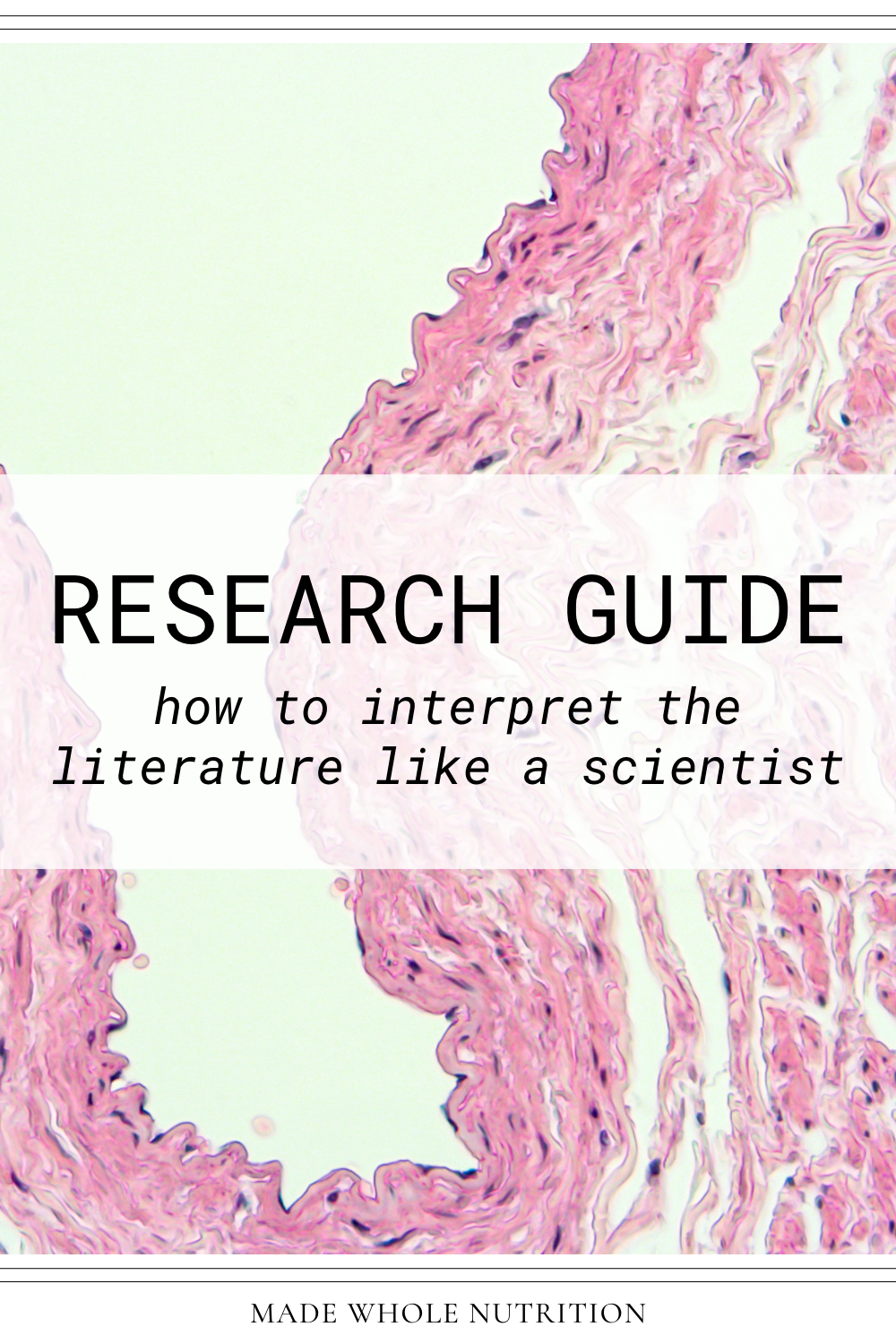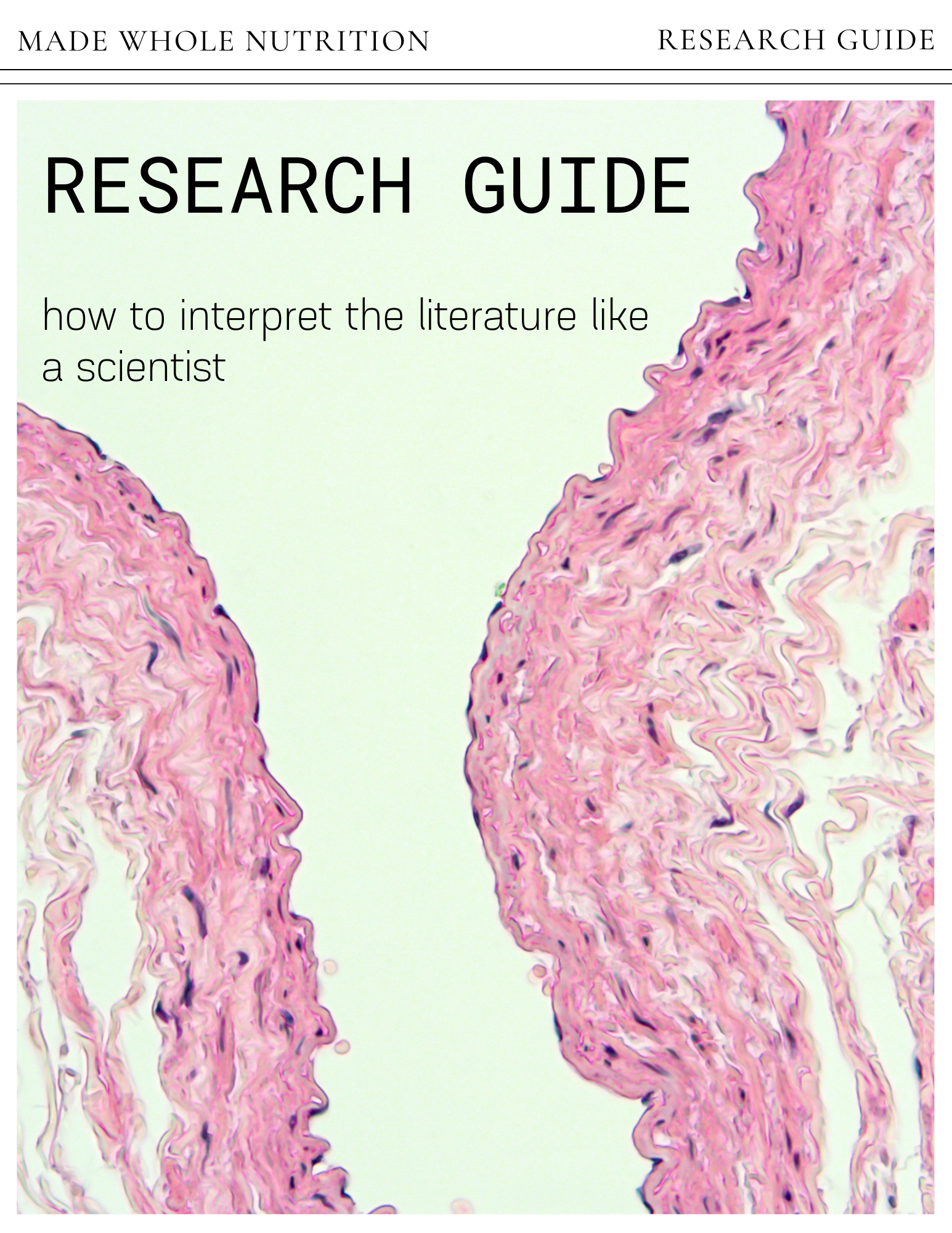RESEARCH GUIDE: how to interpret the literature like a scientist
Nutrition research is inherently difficult to conduct because diet is multi-faceted.
For example, if vegans are found to be healthier, how do you know if it is because they do not eat meat or because they eat more vegetables (or if people who care more about their health tend to be vegan)?
Therefore, it is important to know how to interpret the literature when forming your understanding of nutritional science.
EXAMPLE CLAIM: "An apple a day prevents cancer."
What is the TYPE OF STUDY?
lab (in vitro): exposure to apple extracts prevents cancerous growth in cells in a petri dish (can show direct effect of a single nutrient, but the body is much more complex)
animal (in vivo): rats fed apples do not get cancer as quickly as those that do not (can show effect of a single diet modification, but humans are not rodents)
clinical trial human: in a controlled study, people fed apples for 3 months have less tumor growth than those who do not (shows snapshot in time)
longitudinal human: people who ate an apple a day for 15 years have lower cancer rates than those who did not (shows long-term effects)
epidemiological: in a population, people who eat an apple a day get cancer less often than those who do not (can show patterns in population, but can only show correlation)
meta-analysis: consolidates all the existing data on the effects of apples on cancer (reliable overview)
literature review: a summary report on the existing information on the effects of apples on cancer (more likely to be biased)
correlation: people who eat an apple a day also have lower rates of cancer (may or may not be because of the apples)
causation: eating an apple a day causes decreased tumor growth (evidence to show mechanism of cause-and-effect)
A randomized controlled trial is considered the gold standard study to perform in many instances because it is designed to identify cause-and-effect.
What is the EFFECT?
in a group of 100 people who eat an apple a day, 1 gets cancer
in a group of 100 people who do not eat an apple a day, 2 get cancer
physiological dosage: a slice is not enough, you need to eat one whole apple every day before you see significant preventative effect
statistically significant: strong chance that lower cancer rates in those that eat an apple a day is not just a random occurrence (measured by p-value, under 0.05 usually considered significant)
clinically significant: eating an apple a day makes enough difference in preventing cancer that it is worth doing it (not standardized and open for interpretation)
confidence interval: if we did this study again, there is a strong chance that the result will be within a range of this result (95% usually considered reliable)
probability: of those who eat an apple a day, the probability of getting cancer is 1 in 100
odds: of those who eat an apple a day, the odds of getting cancer is 1 to 99
absolute risk reduction: 1%, because only 1 out of 100 experienced a change (most informative risk stat)
relative risk reduction: 50%, because the initial risk dropped from 2 to 1 (often reported, but not as meaningful)
risk ratio: 0.5, because by eating an apple a day, only 1 person developed cancer compared to 2
odds ratio: 0.49, comparing the odds of getting cancer when you eat apples is (1 to 99) to the odds of getting cancer when you do not eat apples (2 to 98, or 1 to 49)
number needed to treat: 100 people need to eat an apple a day to prevent cancer in 1 person
number needed to harm: 10 people need to eat an apple a day for someone to get bloating from that apple
confidence interval: if we did this study again, there is a strong chance that the result will be within a range of this result (95% usually considered reliable)
Statistics are often selectively reported to make a point.
It is more flashy to say "cancer rates double for people who do not eat an apple a day" than "eating an apple a day reduces cancer risk by 1%", although both are technically true about the same data.
What is the EVIDENCE?
no evidence: there have been no studies done
no effect: eating an apple a day does not change your risk of cancer
evidence against: eating an apple a day increases your risk of cancer
evidence for: eating an apple a day reduces your risk of cancer
inconclusive evidence: some studies show evidence for and some show evidence against (more research is needed)
What are the FINDINGS?
incidence: the number of people who were diagnosed with cancer this year (new cases)
prevalence: the total number of people who have cancer right now (population)
high sensitivity (true positive): told you have cancer when you really do
high specificity (true negative): told you do not have cancer when you really do not
type 1 error (false positive): told you have cancer when you really do not
type 2 error (false positive): told you do not have cancer when you really do
high precision: when repeating a study, all measurements are close to one another
high accuracy: when repeating an experiment, all measurements are close to the true measurement
internal validity: strong chance that the observed effect in the study is from the daily apples
external validity: strong chance that if people outside the study start eating daily apples, they will also experience a beneficial effect





